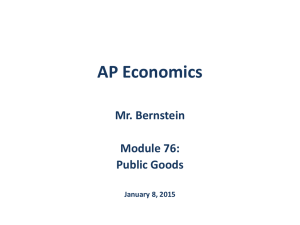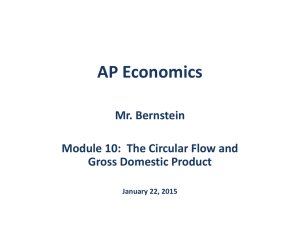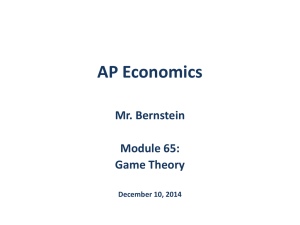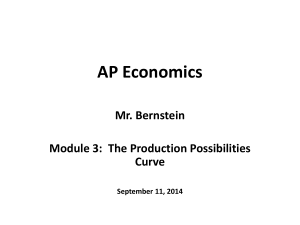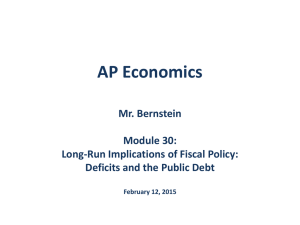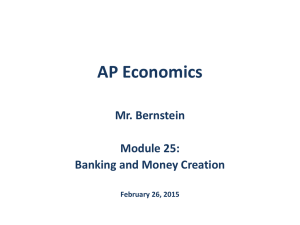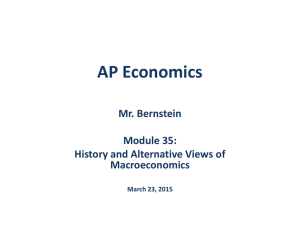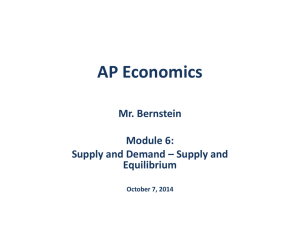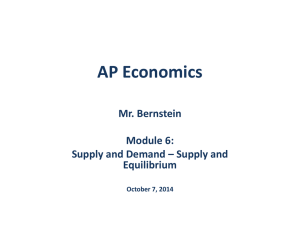Draft Outline of Berstein`s Concepts
advertisement
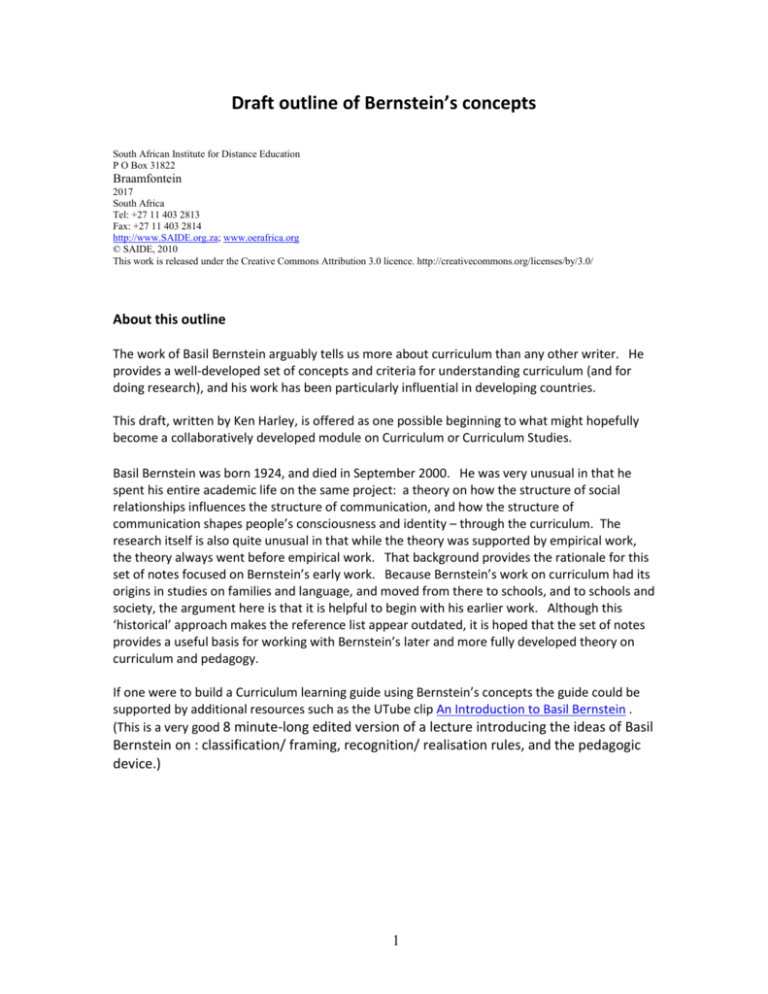
Draft outline of Bernstein’s concepts South African Institute for Distance Education P O Box 31822 Braamfontein 2017 South Africa Tel: +27 11 403 2813 Fax: +27 11 403 2814 http://www.SAIDE.org.za; www.oerafrica.org © SAIDE, 2010 This work is released under the Creative Commons Attribution 3.0 licence. http://creativecommons.org/licenses/by/3.0/ About this outline The work of Basil Bernstein arguably tells us more about curriculum than any other writer. He provides a well-developed set of concepts and criteria for understanding curriculum (and for doing research), and his work has been particularly influential in developing countries. This draft, written by Ken Harley, is offered as one possible beginning to what might hopefully become a collaboratively developed module on Curriculum or Curriculum Studies. Basil Bernstein was born 1924, and died in September 2000. He was very unusual in that he spent his entire academic life on the same project: a theory on how the structure of social relationships influences the structure of communication, and how the structure of communication shapes people’s consciousness and identity – through the curriculum. The research itself is also quite unusual in that while the theory was supported by empirical work, the theory always went before empirical work. That background provides the rationale for this set of notes focused on Bernstein’s early work. Because Bernstein’s work on curriculum had its origins in studies on families and language, and moved from there to schools, and to schools and society, the argument here is that it is helpful to begin with his earlier work. Although this ‘historical’ approach makes the reference list appear outdated, it is hoped that the set of notes provides a useful basis for working with Bernstein’s later and more fully developed theory on curriculum and pedagogy. If one were to build a Curriculum learning guide using Bernstein’s concepts the guide could be supported by additional resources such as the UTube clip An Introduction to Basil Bernstein . (This is a very good 8 minute-long edited version of a lecture introducing the ideas of Basil Bernstein on : classification/ framing, recognition/ realisation rules, and the pedagogic device.) 1 1 A focus on families and language Bernstein (1971)1 argues that the language of working class children is context specific: it is locked into specific relationships in particular social situations, and it is predictable. Because it is context specific, Bernstein calls it a “Restricted Code”. This is contrasted with ‘middle class’ language, in which meaning is more abstract and universalistic, which he calls the “Elaborated Code”.2 Using Bernstein’s constructs of Restricted and Elaborated codes we could construct a simple dichotomous-looking table like the following. Table 1: The theory that social class relationships shape the structure of communication Social Class is ... WORKING CLASS MIDDLE CLASS Spoken language is ... Context bound Less context bound Meanings are ... Particularistic Universalistic Principles are ... Explicit Implicit The Code is RESTRICTED ELABORATED This theory has been very controversial. It could be used to explain a potential relationship between social class and academic performance at school, and in some of the literature it is presented in a deterministic way that Bernstein that would not have approved of. It’s interesting that the introduction to Section 6 in Curriculum (2009)3 notes that by the end of the section, one of the things students would be able to do is: distinguish between everyday knowledge and school knowledge, and explain why this distinction is important for curriculum and classroom practice, especially if the learners are working class (p. 172). This section then includes the classic experiment which Bernstein used to explain his ‘code’ theory. It does so nicely and simply. But a curriculum module might still need to ask whether the social relationships of the working class are the same in our own country as in the UK. 1 Bernstein, B. 1971. Education cannot compensate for society. School and Society: A sociological reader. Cambridge: Open University), 61-66. 2 ‘Code’ refers to the structure of the culture. The code consists of regulative principles, tacitly acquired through induction into a culture (socialisation). 3 Hoadley, E. and Jansen, J. 2009 (2nd Ed.). Curriculum: Organizing knowledge for the classroom. Cape Town. Oxford University Press. 2 2 A Focus on Schools In a paper called ‘Sources of consensus and disaffection in education’, Bernstein (1975) argues that schools transmit two cultures, which he calls the “Instrumental” and the “Expressive”. The following table provides the most basic outline of the argument: Table 2: The two cultures transmitted in schools Type of culture ... INSTRUMENTAL EXPRESSIVE Type of activities ... Concerned with the transmission of formal school knowledge: learners are intended to acquire knowledge and specific vocational skills Concerned with the transmission of values and norms: learners are intended to develop particular kinds of conduct and character Effect of the culture ... Potentially divisive: produce patterns of success and failure. Learners are ranked. Potential for creating consensus by uniting learners. A curriculum module could find Instrumental and Expressive cultures useful in understanding classroom practice. At school level, the question of whether schools do schools do contradictory things like dividing and uniting learners at the same time is an interesting one. The table above provides a useful but static analysis of schools. From empirical studies, Bernstein knew that schools were changing. The focus on schools, and in particular, change in schools, was developed in a paper called ‘Ritual in Education’ (1971). Here Bernstein shows how the Instrumental and Expressive orders are developed through ritual. For example, the Expressive order is maintained through rituals emphasising unity, such as school assemblies, school badges, uniforms, scrolls and plaques. Most importantly, however, Bernstein began to locate changes in schools within different modalities of control. The modalities of control he calls “Stratified” and “Differentiated”. Stratified control has its roots in “Positional” forms of transmission, meaning simply that the status and hierarchy of learners is determined by how they are classified, eg. on the basis of age, gender, and perhaps ability. The important thing about these classifications is that they are based on fixed attributes. Learners can do nothing to change things like age and gender. By contrast, Differentiated control has its roots in “Personal” forms of transmission. Here the learner is conceived not as having fixed attributes, but variable attributes which undergo development and which can be developed by the school and by teachers. In rather simplistic tabular form, here are the features of two types of schools which Bernstein believed could explain change in schools. 3 Table 3: Change in schools: Stratified and Differentiated school types Type of school ... STRATIFIED DIFFERENTIATED Nature of ritual ... Strong ritual: adult imposed Less ritual: pupil imposed Units of organisation are ... Fixed, eg. pupils are grouped according to age, gender, ability Not Fixed, eg. mixed ability, mixed gender groups. Membership of units are ... Fixed (eg. pupil can’t change age, gender etc) Not fixed (eg. pupil is seen as having potential to develop) Boundaries between subjects are ........ Strong Weak Relationships are ... Positional (eg. strong boundaries between hierarchies like subject heads, teachers, learners) Personalised (eg. hierarchies are blurred by personal relationships which can be achieved) School Rituals celebrate Domination Participation Reward and Punishment are ......... Public (form of control is dominance) Less public (form of control is personalised and therapeutic) Roles of teachers and pupils are ....... Clear, ‘given’ Ambiguous; have to be negotiated Students might use these typologies to contribute to their understanding of discourses about curriculum and schooling, curriculum policy, or their own classroom experiences. 3 A focus on Schools and Society If schools are changing, and if one has a description of the changes, how does one explain the reasons for change? Why should schools be changing? Bernstein provides a useful analysis of the relationship between schools and society in his paper ‘Open schools, open society?’ (1971). He believes that the form of the curriculum can be understood only within the context of the society in which it develops. Bernstein presents: (a) an analysis of how social integration is achieved in two different forms of social organisation (or types of societies), and (b) an analysis of how the form of the curriculum is related to the form of social organisation. It’s hard to make sense of what Bernstein maintains about schools without understanding what he says about the form of social organisation. 4 (a) Bernstein' analysis of social integration For Bernstein, integration refers to what binds or keeps people together - although they may have differing interests and outlooks - in a particular society. In this article Bernstein writes about two different forms of social integration, which he calls mechanical and organic solidarity. In developing these concepts Bernstein draws on the work of Durkheim, a French professor in the early part of the twentieth century. Durkheim was much concerned about the effect of the increasingly complex division of labour in society. With more and more people performing specialised roles in the workplace, Durkheim was interested in how this affected social solidarity. He wanted to know what keeps society together and what stops it from falling apart, especially as work roles became more specialised. Durkheim drew a distinction between pre-industrial and industrial societies. In pre-industrial societies, the division of labour was unspecialised. There was comparatively little differentiation of labour. Social solidarity was based on similarities between members of society, who shared similar roles, beliefs, and values. Durkheim was talking here of a close form of communal life. This he called “Mechanical solidarity”. In such a society an individual's outlook was strongly conditioned by a collective conscience. A person was born, lived as a child and adult, and died, very much in the manner of people before him or her. Throughout life, people knew their rights and obligations. In such societies, religion was strong, and the law repressive - to break the law in such a society was to challenge the existence of society. One way of looking at socialisation is to say that members of society were produced from the same "mould". However, as technology advanced, individuals began specialising in particular occupational roles. Goods and services were thus produced more efficiently. In such a society, the nature of social solidarity is what Durkheim called “Organic”. Members were now interdependent in the sense that each became dependent on each other's specialised skills. The exchange of goods and services now required rules and regulations in order to provide a legal framework of co-operation. Legal contract, rather than consensus, provided a framework for what was regarded as fair, reasonable and legitimate. So, if society was held together by covenant in a mechanical form of solidarity, it is held together by contract in an organic solidarity. In table form, we could represent the two kinds of solidarities as follows: 5 Table 4: Two types of social solidarity: Mechanical and Organic Type of solidarity MECHANICAL ORGANIC Division of labour is ... Simple Complex Individuals ... Resemble each other Differ from one another Social roles are ... Ascribed (‘given’) Achieved Modes of control are ... Positional Personalised Social cohesion based on ... Common faith or belief Contractual relationships Common faith is sustained by ........ Penal law (a public demonstration of the consequences of the violation of norms) Civil law (‘restitutive’) aimed at restoring things to the way they were previously (b) The effect of organic solidarity on schooling and curriculum Writing about British schools in the late 1960s, Bernstein argued that secondary schools reflected a shift from mechanical to organic solidarity. Some of the main points he makes about the changes that occurred in the 1960s and 1970s and that still affect us are: 1 Social control: Bernstein argues that social control was now based less on shared values than on personalised forms of control where teachers and taught confront each other as individuals. Teachers could no longer control learners easily by virtue of the simple fact that they were teachers, and that learners automatically had respect for teachers. Teachers had to impress pupils as individuals who warrant being taken seriously. For teachers, the change was thus from positional to personal authority. 2 The division of labour in schools became more complex because more subjects were being taught. The teacher's role also became fragmented and specialised, eg. counsellors, and so on. Learners’ relationships with each other were built, in many cases, around educational differences. While in Mechanical Solidarity one would expect homogenous learning, and much commonality, there was now a tremendous amount of differentiation in terms of subject choice, but often too in terms of ability. 3 New teaching methods: The teacher was now often a problem-poser and ‘facilitator’ rather than solution-giver. This had important implications for the nature of authority. 4 Referring more specifically to curriculum, Bernstein argues that schools have moved away from education in depth to education in breadth. Subjects were no longer as insulated as in the past, and boundaries between subjects were breaking down. Knowledge integration became a feature of many curriculum policies. 6 Bernstein’s own writing is not always easy to follow, and his use of terminology is sometimes a little confusing. The paper is titled ‘Open schools, Open society?’ but in the paper, after describing Mechanical and Organic solidarity, refers to closed and open schools instead. ("Closed" schools have reference to Mechanical Solidarity, while "Open" schools are rooted in Organic Solidarity. “Closed” schools is the term to replace what Bernstein referred to as “stratified” schools in the earlier paper; similarly, “Open” schools corresponds with the earlier term “differentiated”. ) All of the above is background to Bernstein’s most influential work on “Classification” and “Framing” (1971). 4 A Focus on Curriculum and Society There’s a logical development from Mechanical and Organic Solidarity to what Bernstein called Closed and Open schools, and from there to his work "On the Classification and Framing of Educational Knowledge" (1971). Educational knowledge is to a greater or lesser extent a "mould" which shapes our identities. Part of the account we give of ourselves is provided by the school. For example, we may define ourselves as "good" or "bad" scholars; or perhaps we see ourselves as "good" at languages, and "bad" at mathematics. Our identities, or our sense of who we are, is realised or brought about through what Bernstein calls three "message" systems: curriculum, pedagogy, evaluation. (a) Curriculum By this Bernstein means what is defined as knowledge. Transmitted knowledge (or content) is a selection of knowledge. Some knowledge is regarded as appropriate, while other knowledge is not. For example, it has become legitimate for history teachers to deal in class with the hereditary line of Zulu kings, but not with the pedigree of racehorses entered for the July Handicap. (b) Pedagogy Bernstein defines pedagogy as the form or mode of transmission of education. More simply, I think we might see pedagogy as how the selection of knowledge is taught (what some people would call "methods"). (c) Evaluation The more usual term for this is "assessment" or even more simply, "testing”. The point Bernstein makes is that evaluation is dependent on, or is constrained by, curriculum and pedagogy. In his "Classification and Framing" article Bernstein analyses the structure of three "message systems". First, he distinguishes between a Collection type curriculum and an Integrated type curriculum. In the "Collection" code, subjects have very distinct boundaries and are well insulated from each other. Subjects are kept apart. In the "Integrated" code, there is little insulation of subjects. 7 The curriculum may be based on themes - for example, in the primary school, a theme like "Transport" may include the history of transport; using geography, the patterns of trade may be traced; physics may provide a view of the principles of steam engines, which revolutionised transport; and the class may read a poem like "Transport rider", etc. Next, Bernstein introduces the concepts of Classification and Frame. Classification does not refer to what is classified, but to the boundary strength between what is classified. Strong Classification means strong boundaries, such as when the timetable consists of clearly separate subjects, eg. English, Zulu, Maths, etc. Weak Classification refers to weak boundaries between the subjects. Strong Classification is characteristic of the Collection code; and Weak Classification characteristic of Integrated code. "Frame" refers to the message system of pedagogy. Do teachers and pupils control content, how it is organised, how it is sequenced, and so on? A syllabus with rigid topics, to be completed in a predetermined order, within a specified time, would represent strong framing. Weak framing would occur when the teacher is able to select topics on the basis of pupil interest, or some other such principle, and organise the sequence and pacing of material according to pupil readiness and stage of development. A further distinction between Classification and Framing is that while Classification is associated with power, Framing is associated with control. The strength of Classification and Frame may vary independently. Expressed differently, one may be weak, and the other strong. For example, programmed learning or computer-based learning could have either strong or weak Classification, depending on whether it is subject based, or thematically based. But either way, Framing will be strong: a learner has no control over what is learned. This is built into the fixed design. Classification and Framing provide interesting theoretical concepts for comparing systems. For example, at the time when Bernstein wrote this article, the British system was strongly subjectbased, but teachers had an enormous amount of power in terms of what content they taught, and how they organised and sequenced it. This was an example of strong Classification, and weak Framing. After the introduction of the National Curriculum in 1988 "benchmarks" were created for purposes of monitoring learner progress on a national scale. Strong Framing had now been brought into being. In the USA, subject-based teaching has never been very strong, and teachers have had a good deal of control over the curriculum. Both Classification and Framing have been historically weak. Students could find Classification and Framing useful concepts for understanding their own national curricula in terms of how strong or weak each is. Their usefulness extends beyond a mere labelling exercise though. The concepts can be very useful for students’ understanding of 8 their own professional identities. Bernstein makes it clear that these concepts have very marked implications for the way in which teachers and learners construct their identities. In considering the Collection Code (with its strong Classification), Bernstein argues that strong educational identities are established early in people's educational careers. Strong Classification provides a strong system of grading - you know exactly how well you are doing in the system, and where you are in the academic hierarchy. In the Collection Code, knowledge is sacred, and is regarded as private property. Pupils are socialised into that view early in their careers. Knowledge is organised hierarchically, and the ultimate mystery of the subject is revealed only later on in one's career. Subject loyalty is systematically developed, and you have to demonstrate it before being allowed to proceed further. Study is very specialised, and it emphasises differences between practitioners of different subjects, not communality with. Practitioners have a strong sense of identity and subject loyalty. The stronger Classification and Framing, the more hierarchical and ritualised educational relationships are. Pupils too, have little status - the teacher has possession of knowledge. The Collection code socialises learners into seeing knowledge as something quite distinct from everyday knowledge. What are the implications for personal identity of the Integrated Code, with its weak Classification? Because the various subjects are in a more open relationship, Bernstein suggests that the Integrated code will probably have a more uniform pedagogy. Teachers of the same subject will have to work more closely for a start, and this will probably lead to more homogeneous teaching approaches. "Team teaching" becomes much more of a possibility in an Integrated code. Within an integrated code, teachers' professional identity is uncertain: it has to be achieved in the context of interpersonal negotiation with colleagues. This differs markedly from the Collection code, where professional identity is prescribed, eg. you are a Maths teacher; or you teach Woodwork. In the Collection code, Bernstein argues that the process is working from surface structure to the deep structure of the subject. If content is more open to negotiation, as in the Integrated code, there is an earlier introduction to the deep structure of the subject. Bernstein illustrates this point with reference to Science. In a Collection code syllabus, a topic like "movement" will appear many times, eg. in discussions on gravity, propulsion, capillarity etc. But each time movement is discussed, what you are doing is dealing with a surface manifestation of the deeper phenomenon of the nature of scientific movement. In an integrated code, those deeper principles form the essence of the enquiry from the outset: one wants to know how the principles of movement apply to the over-arching topic or theme. Bernstein suggests that the Integrated code brings about a shift in the balance of power between teacher and taught - the pupil has more access to knowledge, especially deep structure knowledge. This is potentially threatening to teachers – they are not as firmly in control of subject matter as they are in a Collection code. Also, teachers have to be very much more 9 capable if they are to handle the Integrated code - they need to be able to analyse and synthesise information. They have to be able to handle uncertainty and ambiguity. Assessment becomes problematic - you may need to use a wider repertoire of testing techniques. The interesting point is that a wider range of pupil attributes may be evaluated in an Integrated code. Attributes of personality may be involved, e.g. oral and not just written assessment in the languages. The Collection and Integrated codes do not have consequences for personal identity only. They also have organisational consequences (the diagram on page 62, Bernstein, 1971, is very useful). Socialisation is a lot more unpredictable with Integrated codes. The outcomes of enquiry-based topics will have a greater degree of uncertainty than the ritualised following of a syllabus in a Collection code. Finally, one could link Collection and Integrated codes with mechanical and organic solidarities. Bernstein argues that a shift from a Collection code to an Integrated code corresponds to a change from Mechanical to Organic solidarity. In his view, there is a strong association between a Collection code and Mechanical solidarity: both are based on the idea of traditional authority; both have strong vertical, hierarchical authority relationships; people in both can locate themselves within a very structured system; control is predictable; teachers and pupils know their rights and obligations; people develop from the same "mould"; there is consensus regarding values; and identities are ascribed. The Collection code reflects and reproduces an essentially mechanical, segmented and hierarchical mode of organisation and control. Similarly, Bernstein links the Integrated code and Organic solidarity. Both have the same characteristics. Members are now interdependent in the sense that each is dependent on each other's specialised skills. The exchange of goods and services requires rules and regulations in order to provide a framework of co-operation. Identities are achieved. That accurately describes the internal division of labour in society and the social organisation of the school with an Integrated code. Why should there be a shift from collection to integrated code? Bernstein relates this to: (a) Changes in technology, which create new educational categories, eg. psycho-linguist, bio-physicist. Environmental issues, for example, bring together people from many different subject disciplines. New issues and new technologies demand new skills, and flexible workers who can unlearn and relearn. (b) Bernstein suggests that a change to Organic solidarity stems from change in the moral order of society. He suggests that this happens when there is a crisis in society's structures of power and principles of social control. The movement to Organic solidarity is linked to the social power structure and is an attempt to change the collective consciousness of people. Overall: Bernstein is mapping educational and curriculum change within the process of social change. 10 For Bernstein, the curriculum is not a neutral package of knowledge responding in some ‘natural’ way to the demands of society. It increases a learner’s knowledge, but most importantly, moulds a learner's attitude towards reality. It operates as a form of control. A shift from Collection to Integrated codes disturbs power relationships and educational identities. A rather complex sentence captures the essence of Bernstein’s argument: How a society selects, classifies, distributes transmits and evaluates the educational knowledge it considers to be public, reflects both the distribution of power and the principles of social control (1971: 47). Finally, it might be helpful to go right back to the beginning of Bernstein’s work to consider the value position that underpinned his academic work. In fact he kept his personal values to himself and revealed them explicitly only late in his life. ‘Conditions for democracy’ Bernstein maintains that for democracy to be realized, parents and learners (and teachers?) must have a stake in the school and its organization and arrangements. For that, certain conditions must be realized. These conditions are positioned in the following table.4 Table 5: Conditions for democracy Rights Enhancement Inclusion Participation Conditions Confidence Communitas Civic discourse Levels Individual Social Political Enhancement: the right to be more (personally, socially, intellectually) but it’s also about access to the means of critical understanding and to ways of thinking about new possibilities. The condition for that is confidence. Without confidence, it is difficult to act. The confidence we’re talking about here is at the individual level. Inclusion: This means the right to be included socially, culturally (this is not the same as being absorbed and it includes the right to opt out of certain things, to be autonomous). Inclusion operates at the social level. Participation : This is the right to participate in procedures whereby order is constructed, maintained and changed. But it’s not only discourse and discussion. It’s about participating in practices and events too. Participation is the essential condition for civic practice, and it operates at level of politics. 4 Bernstein, 1996: 7 11 These value concerns are concepts that can be used in our own enquiries as practitioners or in formal research. For example, if we wanted to know the extent to which our school was fostering democratic practices, we could measure them against Bernstein’s table of rights. 1 Do these rights exist, are the conditions met? 2 Do they apply to all learners, or just to some? These might also be of use in regard to understanding the ‘Hidden Curriculum’. Conclusion Bernstein’s concepts could be very useful in any module on Curriculum or Curriculum Studies. They can assist in our understanding of school and society; schools as organisations; the formal and non-formal curriculum; teacher identity; and the practice of teaching and assessing. They can also serve as useful tools for reflection – and most teacher education programmes appear to be based on a reflective practitioner model. In this way they can also help soften the divide between pre- and in-service teacher education. Similarly, as these concepts are very useful in formal research, they can soften the divide between teacher education aimed at developing good practice and higher degree studies focused on research in education. References Bernstein, B. 1971. Open schools, open society? In B R Cosin et al (eds). School and society: a sociological reader. Cambridge, Massachusetts: MIT Press, 66-69. Bernstein, B. 1971. On the classification and framing of educational knowledge. In MFD Young (ed). Knowledge and Control: New directions for the sociology of education. London: Collier MacMillan, 47-69. Bernstein, B., Elvin, H., and Peters, R.S. 1971. Ritual in Education. In B R Cosin et al (eds). School and society: a sociological reader. Cambridge, Massachusetts: MIT Press), 160-165. Bernstein, B. 1975. Sources of consensus and disaffection in education. Class, Codes and Control. London: Routledge and Kegan Paul. Bernstein, B. 1996. Pedagogy, symbolic control and identity: theory, research, critique. London: Taylor and Francis. Durkheim E. 1964. The division of labour in society. New York: MacMillan. 12

